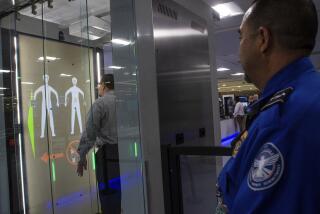Bag Scanning System Called Easily Foiled
WASHINGTON — The $1-million machines the government plans to deploy by the hundreds to scan airline baggage for bombs have been foiled repeatedly by undercover teams simulating terrorists, a veteran federal agent charged Wednesday.
“We were extraordinarily successful in mock-destroying aircraft and killing large numbers of innocent people in . . . simulated attacks,” said Bogdan Dzakovic, supervisor of a special Federal Aviation Administration team that tested airport security. “This occurred with such regularity and ease as to present a frightening picture of the sorry state of aviation security on a worldwide basis. This was all before 9/11.”
These and other public allegations by Dzakovic raise questions about the government’s effort to ensure that all checked bags are screened effectively for hidden bombs by the end of the year. The charges also provide a glimpse of the highly secretive manner in which plainclothes agents test the nation’s aviation security system.
The Office of Special Counsel, an agency charged with protecting federal whistle-blowers, asked Transportation Secretary Norman Y. Mineta earlier this month to investigate allegations by Dzakovic that FAA managers suppressed information about gaps in airport security.
A former air marshal and 14-year veteran of FAA security, Dzakovic supervised an FAA “red team” that was charged with aggressively trying to expose gaps in security. Beginning in 1999 and continuing until a few weeks before the Sept. 11 attacks, Dzakovic said, red team undercover tests found poor detection rates by machines that were supposed to find bombs. However, it was not clear whether the problem was with the machines, their human operators, or the interaction of technology and operator.
Fewer than 200 of the machines are now being used at airports around the country, including Los Angeles International. An estimated 2,990 would be needed to cover all 429 airports with regular airline service, at a cost of more than $2.5 billion.
Senior spokesman Chet Lunner said Mineta has asked Transportation Inspector General Kenneth Mead to investigate Dzakovic’s charges, some of which concern incidents in the mid- to late 1990s. “The secretary has asked the inspector general to vigorously pursue these allegations,” Lunner said.
A new Transportation Security Administration, headed by a former Secret Service director, has taken over security from the FAA and the airlines. “Our current system is not the subject of these allegations,” Lunner said. “We are confident that the system we have now in place is an improvement. . . . Security is much tighter.”
But Dzakovic, who is now a Transportation Security Administration employee, said the new agency is working with the same equipment and many of the same people as the old FAA security division. “It’s a big mistake, how they’re doing it,” he said, of the explosive detection effort. He spoke at a news conference in support of new legislation to strengthen whistle-blower protections.
Rep. Edward J. Markey (D-Mass.), a senior member of the House Commerce Committee, said the allegations are worrisome. “I have written letters to the FAA and the Department of Transportation to encourage the testing and approval of a variety of new technologies to protect our airports,” Markey said. “It is not enough to rely on one type of technology to protect the public against the multiplicity of threats that the post 9/11 world has shown us is likely.”
The baggage scanners--which are the size of a large automobile and can be seen in major airport lobbies--are considered a state-of-the-art means of detecting explosives. They rely on CT technology similar to that used for medical diagnosis, and are widely considered to be superior to traditional X-ray machines.
The actual detection rate of the CT-based machines is classified. The Transportation Department inspector general has said that they are effective in finding explosives, but that operators can be prone to error as they make split-second judgments on bags identified as suspicious by the scanner.
However, in congressional testimony last October, a Defense Department official charged with overseeing FAA tests of the equipment said the technology itself leaves something to be desired.
“I can state unequivocally . . . that the current levels that have been established for positive explosives detection [and] permissible false alarm rates . . . are not those rates desired by the aviation industry,” said James O’Bryon, then deputy director of live-fire testing for the Pentagon.
“Rather, these thresholds have been driven by the inability of the current equipment to perform any better,” O’Bryon added. “If the thresholds were tightened by only a couple of percentage points, there would currently be few, if any [explosive detection] equipment certified at all.”
Dzakovic said results were “so poor” when his team first conducted its undercover tests that his supervisor tried to cover up the problem. Dzakovic was ordered to alert FAA officials at local airports in advance of any further testing.
“My next two trips to test security under these conditions resulted in 100% detection,” Dzakovic said. “I stopped making notifications after this and our testing results returned to their normal low levels. Our government is now poised to spend $2 billion on these machines.”
Transportation Department officials have said they are looking at a variety of methods to meet a year-end congressional deadline for screening about 1 billion checked bags with explosive detection equipment.
(BEGIN TEXT OF INFOBOX / INFOGRAPHIC)
Looking Through Luggage
(text of infobox not included)
More to Read
Sign up for Essential California
The most important California stories and recommendations in your inbox every morning.
You may occasionally receive promotional content from the Los Angeles Times.










